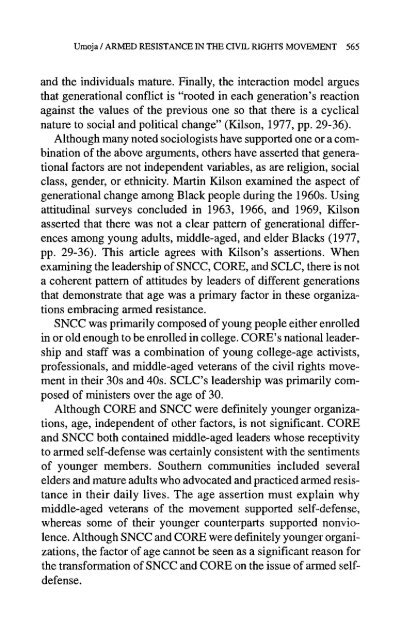MXGM Self-Defence Manual
MXGM Self-Defence Manual
MXGM Self-Defence Manual
Create successful ePaper yourself
Turn your PDF publications into a flip-book with our unique Google optimized e-Paper software.
Umoja / ARMED RESISTANCE IN THE CIVIL RIGHTS MOVEMENT 565<br />
and the individuals mature. Finally, the interaction model argues<br />
that generational conflict is "rooted in each generation's reaction<br />
against the values of the previous one so that there is a cyclical<br />
nature to social and political change" (Kilson, 1977, pp. 29-36).<br />
Although many noted sociologists have supported one or a combination<br />
of the above arguments, others have asserted that generational<br />
factors are not independent variables, as are religion, social<br />
class, gender, or ethnicity. Martin Kilson examined the aspect of<br />
generational change among Black people during the 1960s. Using<br />
attitudinal surveys concluded in 1963, 1966, and 1969, Kilson<br />
asserted that there was not a clear pattern of generational differences<br />
among young adults, middle-aged, and elder Blacks (1977,<br />
pp. 29-36). This article agrees with Kilson's assertions. When<br />
examining the leadership of SNCC, CORE, and SCLC, there is not<br />
a coherent pattern of attitudes by leaders of different generations<br />
that demonstrate that age was a primary factor in these organizations<br />
embracing armed resistance.<br />
SNCC was primarily composed of young people either enrolled<br />
in or old enough to be enrolled in college. CORE's national leadership<br />
and staff was a combination of young college-age activists,<br />
professionals, and middle-aged veterans of the civil rights movement<br />
in their 30s and 40s. SCLC's leadership was primarily composed<br />
of ministers over the age of 30.<br />
Although CORE and SNCC were definitely younger organizations,<br />
age, independent of other factors, is not significant. CORE<br />
and SNCC both contained middle-aged leaders whose receptivity<br />
to armed self-defense was certainly consistent with the sentiments<br />
of younger members. Southern communities included several<br />
elders and mature adults who advocated and practiced armed resistance<br />
in their daily lives. The age assertion must explain why<br />
middle-aged veterans of the movement supported self-defense,<br />
whereas some of their younger counterparts supported nonviolence.<br />
Although SNCC and CORE were definitely younger organizations,<br />
the factor of age cannot be seen as a significant reason for<br />
the transformation of SNCC and CORE on the issue of armed selfdefense.


